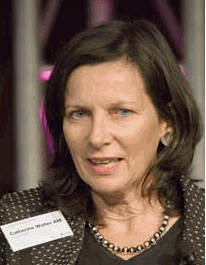|
|
|
|
|
|
|
News & Views item - December 2009 |
![]() Troubles at the Australian Synchrotron the Subject of Increasing International
Coverage. (December 11, 2009)
Troubles at the Australian Synchrotron the Subject of Increasing International
Coverage. (December 11, 2009)
The two prestigious scientific weeklies, Nature and Science are featuring reports of the turbulent ructions between the Australian Synchrotronís governing board, chaired by businesswoman Catherine Walter, in one corner and the synchrotron staff members and the facility's international scientific advisory committee (SAC) in the other.
To recapitulate: this past October 30, the governing board informed the synchrotron's founding director, the professor of chemistry at The University of Melbourne Robert Lamb, that his services were no longer required. Repeated demands by staff and the SAC for an explanation for the dismissal as well as requests by the media have been met by Ms Walter claiming that the reasons for Lambís dismissal could not be discussed because of ďlegal and confidentiality constraints.Ē
On December 4 Professor Lamb issued a public statement:
|
|
I have not been informed in detail or really at all of the reasons for the ending of my secondment to the Australian Synchrotron 5
 Ms Catherine Walter |
weeks ago. I donít know why this would of occurred. It is personally distressing but I am very concerned about the smooth operation of our Australian Synchrotron. We were running at 1% below budget in the past year, have raised in conjunction with the science community almost $ 55 million in 2009 alone and are successfully meeting the research needs of both the national and international science community. I am at a loss and until I am enlightened I am unable to usefully comment further. I appreciate the support of the scientific community and the overwhelming support of other groups that have contacted me. Most recently I accepted an invitation from the Asian Synchrotron Science community to be their guest at the annual Asia Synchrotron meeting held in Shanghai this past week. I know the University of Melbourne has demanded an explanation from the Board but it is several weeks overdue.
The SAC chair Frank Larkins told Nature "We have drawn a line in the sand. Of the 40-odd synchrotrons around the world, I don't think this has ever happened before." He went on to say that the row is partly a result of a culture clash between the business-oriented Ms Walter and the scientists. "The 'bottom-line' priorities for the scientists are matters such as publications in high-impact journals," and says the board is more focused on financial factors that "have to be balanced with the science priorities".
Now Elizabeth Finkel in the December 10, 2009 ScienceInsider reports: "Yesterday a showdown at the Australian Synchrotron failed to resolve tensions between the warring factions."
Synchrotron staff and the SAC had again demanded an explanation for Professor Lamb's sacking and that Ms Walter resign from the board. Ms Walter refused to resign and read a prepared speech which she made available to ScienceInsider which, however, is not published.
The Australian reports: "Obviously the publicity has affected the
synchrotron's reputation," [Ms Walter] said in notes released by the board's
public relations agent.
"However, if the damage was irreparable (former Australian of the Year)
Gus Nossal wouldn't be heading up our new (National Science
Colloquium) body and
Peter Colman (from the Walter and Eliza Hall Institute)
would not have accepted a position on the Board."
She said she would not resign and while any resignations from the Larkins
committee were regrettable, "we will look to appoint other appropriately
credentialed members".
However, it should be noted that Ms Walter is a member of the board of WEHI and of course Professor Nossal is a former head if the Institute.
In the latest development seven of the nine members of SAC resigned yesterday and it is likely that one more will follow. Only Professor Ted Baker, from the University of Auckland looks to be staying on. He told The Australian: "I fully agree with all the views expressed by my colleagues (on the Larkins committee) about the broken relationships between the board and the committee, staff and science community. Changes in governance are desperately needed, but I have chosen not to resign in the hope that I can influence changes for the good."
In his resignation letter, SAC member Michael Grunze, a professor of Applied Physical Chemistry at the University of Heidelberg in Germany, wrote:
The professional advice of SAC, drawn collectively from many decades of collective experience at synchrotron facilities worldwide, has either been consistently ignored or not acted upon in a timely manner by the leadership of the AS Board. ... [This] is unprecedented in my experience as a previous chair of the BESSY SAC in Berlin and a member of the European Synchrotron Radiation Facility Board in Grenoble. I am very much concerned at the undue interference, especially by the chair, in day to day operational matters.
In addition he told ScienceInsider's Ms Finkel: "Itís a long trip to Australia; I made many such fly in, fly out trips. Being ignored, personally, I was offended. Iíve never been treated in such a way by the chair of a board. So I made it clear, as long as the present chair continues, I am not willing to continue to offer my time and advice to the board of the AS.Ē
In a collective statement synchrotron scientists wrote: "[we] are demoralised by the breakdown between the Board and the SAC. These eminent scientists have been our mentors, highly involved with the Australian Synchrotron since its inception and their absence will create a huge void in the scientific leadership of the facility."
Whether or not Ms Walter will be prepared to resolve the impasse by withdrawing from the board remains to be seen, and if even then an effective revamped governance structure can be put in place is moot.